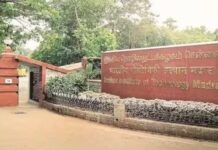By Abdul hafiz lakhani Ahmedabd/ Rajkot
State is in the midst of a major drinking water shortage in villages
The Saurashtra-Kachchh region of Gujarat is facing a severe water crisis. The situation is particularly acute in Rajkot, Jamnagar, Surendranagar and Amreli. Rajkot residents get water on alternate days for half an hour and a bucket costs anywhere between Rs 4 to Rs 10.
Villagers scour the countryside to tap drinking water sources. However, the water table has already fallen to 150-200 feet. To stave off the scarcity, pipelines are being laid on an emergency basis in Surendranagar district. This project will cost Rs 60 crore. Standing crops of groundnut and cotton on more than 400,000 hectares have been ruined in the district.
“In the Saurashtra region people fetch water from sources located around 15 km away from their homes. Irrigation water is supplied only for four hours, instead of promised 14 hours,” says a local politician. With rising mercury levels and severe heatwave, Gujarat is facing a massive water crisis. The scarcity is particularly acute in the Saurashtra region, Kutch, North Gujarat and parts of tribal pockets in central and South Gujarat.
More than 20 districts are severely affected as towns and villages hardly get water twice a week. In more than 500 villages in 14 districts, drinking water is being supplied through tankers; the number will only rise in days to come.
Recently, Gujarat Chief Minister Vijay Rupani admitted that the State is in the midst of a major water shortage but assured that drinking water will be provided to every village. Except the Narmada, all other waterbodies and dams have negligible water, he said.
The challenge
“The available water in all the dams of these regions is negligible. However, thanks to the Sardar Sarovar dam and the Narmada canal network, people will not face any difficulty till July-end. Water is available in the dam. The only challenge is to supply it to far-flung areas, some 500 km away from the dam,” Mr. Rupani said after reviewing the situation.
Subsequently, the State government asked the district administrations to start plying tankers in villages where water was not available.
“After a review and reports from local authorities, we have decided to provide drinking water to villages located in different districts by tankers so that people don’t face any shortage,” said Deputy Chief Minister Nitin Patel.According to officials, the number of villages needing water tankers will only rise due to high temperatures that push the demand.
Supply on alternate days
In Rajkot, water is supplied only for 20 minutes a day and in many localities and societies located on the outskirts, supply is on alternate days or through tankers.Even in Jasdan, the Assembly constituency of Kuvarji Bavalia, the Water Supply Minister, shortage of drinking water forced villagers to hold protests demanding its regular supply.
MLAs’demand
Local legislators have made representations demanding adequate water supply in areas where the Narmada water is the only source now.“In my area, more than two dozen 
villages are facing acute shortage. I have written to the Minister and demanded that all villages are provided water through tankers and tanker trips be doubled,” said Congress legislator Virji Thummar from Amreli district.
However, Chief Minister Vijay Rupani also said that the people will not face any difficulty in getting drinking water till July end, when monsoon sets in. ani held a review meeting on water scarcity situation with senior officials of Water Resources department.
Worst drought since 1985, but no water for Kutch farms
Agriculture and animal husbandry are the predominant economic activities in Kutch. About 72% of land holdings are with small and marginal farmers such as Patel.
Three decades of relentless water extraction have left farmers with little by way of groundwater, and Kutch, a dry zone, has no other natural water source. “Earlier, at least we had some groundwater though we had to bore deep for it. Now, even that has dried up and the water we get by boring deeper is not usable for farming,” Patel explained.
Farmers like him are questioning why cities and factories, and not farms, are receiving water.
Industries in the Kutch and Saurashtra regions are taking water amounting to 844.85 mld (0.25 MAF) against their allocation of 675.88 mld (0.2 MAF). All the industries set up in these regions show the Sardar Sarovar Dam as their main source of water supply, while farmland remains parched.
“Industry and factories get water. Mundra, Mandvi… where there are factories, there is water, there is a pipeline,” Patel told IndiaSpend. “But for farmers, there is never water. The government doesn’t want to give it.”
In the village of Bhangor, located in the Jamnagar constituency, not a single voter out of 3,344 cast a ballot in three polling booths. Crop failure, water scarcity, and inadequate insurance payouts were cited as reasons. This was despite efforts by election officials and even the Police Superintendent, encouraging them to exercise their franchise.
Similarly, a boycott was witnessed in Dhavadad, located in the state’s Dang district over lack of a construction of a road. In another village, Nanda, just one voter cast a ballot. The Wirereported election boycotts in the Amreli and Jamnagar districts.
Issues related to water shortages have long been plaguing the state, which witnessed a rain deficit of ten percent in 2017. This only worsened in 2018, as the state recorded a mere 75 percent of its average rainfall over the past thirty years during that year’s monsoon season.

































